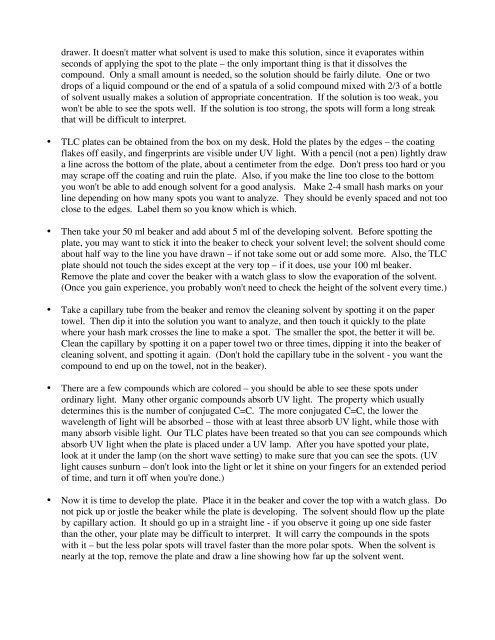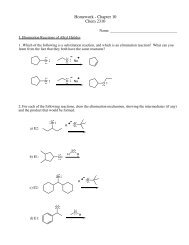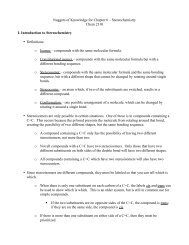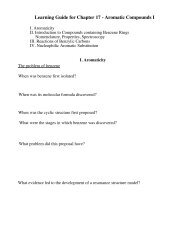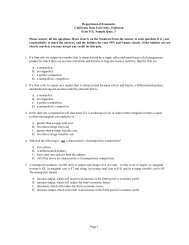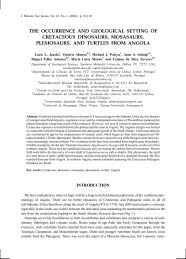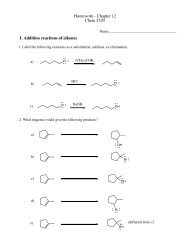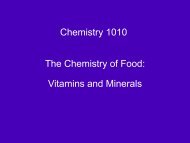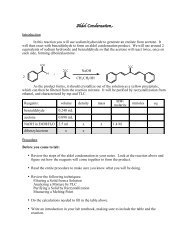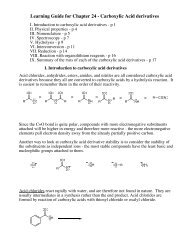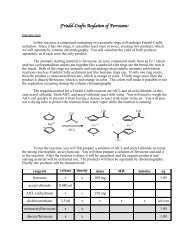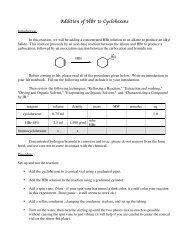Analyzing a Mixture by Thin Layer Chromatography (TLC)
Analyzing a Mixture by Thin Layer Chromatography (TLC)
Analyzing a Mixture by Thin Layer Chromatography (TLC)
You also want an ePaper? Increase the reach of your titles
YUMPU automatically turns print PDFs into web optimized ePapers that Google loves.
drawer. It doesn't matter what solvent is used to make this solution, since it evaporates within<br />
seconds of applying the spot to the plate – the only important thing is that it dissolves the<br />
compound. Only a small amount is needed, so the solution should be fairly dilute. One or two<br />
drops of a liquid compound or the end of a spatula of a solid compound mixed with 2/3 of a bottle<br />
of solvent usually makes a solution of appropriate concentration. If the solution is too weak, you<br />
won't be able to see the spots well. If the solution is too strong, the spots will form a long streak<br />
that will be difficult to interpret.<br />
• <strong>TLC</strong> plates can be obtained from the box on my desk. Hold the plates <strong>by</strong> the edges – the coating<br />
flakes off easily, and fingerprints are visible under UV light. With a pencil (not a pen) lightly draw<br />
a line across the bottom of the plate, about a centimeter from the edge. Don't press too hard or you<br />
may scrape off the coating and ruin the plate. Also, if you make the line too close to the bottom<br />
you won't be able to add enough solvent for a good analysis. Make 2-4 small hash marks on your<br />
line depending on how many spots you want to analyze. They should be evenly spaced and not too<br />
close to the edges. Label them so you know which is which.<br />
• Then take your 50 ml beaker and add about 5 ml of the developing solvent. Before spotting the<br />
plate, you may want to stick it into the beaker to check your solvent level; the solvent should come<br />
about half way to the line you have drawn – if not take some out or add some more. Also, the <strong>TLC</strong><br />
plate should not touch the sides except at the very top – if it does, use your 100 ml beaker.<br />
Remove the plate and cover the beaker with a watch glass to slow the evaporation of the solvent.<br />
(Once you gain experience, you probably won't need to check the height of the solvent every time.)<br />
• Take a capillary tube from the beaker and remov the cleaning solvent <strong>by</strong> spotting it on the paper<br />
towel. Then dip it into the solution you want to analyze, and then touch it quickly to the plate<br />
where your hash mark crosses the line to make a spot. The smaller the spot, the better it will be.<br />
Clean the capillary <strong>by</strong> spotting it on a paper towel two or three times, dipping it into the beaker of<br />
cleaning solvent, and spotting it again. (Don't hold the capillary tube in the solvent - you want the<br />
compound to end up on the towel, not in the beaker).<br />
• There are a few compounds which are colored – you should be able to see these spots under<br />
ordinary light. Many other organic compounds absorb UV light. The property which usually<br />
determines this is the number of conjugated C=C. The more conjugated C=C, the lower the<br />
wavelength of light will be absorbed – those with at least three absorb UV light, while those with<br />
many absorb visible light. Our <strong>TLC</strong> plates have been treated so that you can see compounds which<br />
absorb UV light when the plate is placed under a UV lamp. After you have spotted your plate,<br />
look at it under the lamp (on the short wave setting) to make sure that you can see the spots. (UV<br />
light causes sunburn – don't look into the light or let it shine on your fingers for an extended period<br />
of time, and turn it off when you're done.)<br />
• Now it is time to develop the plate. Place it in the beaker and cover the top with a watch glass. Do<br />
not pick up or jostle the beaker while the plate is developing. The solvent should flow up the plate<br />
<strong>by</strong> capillary action. It should go up in a straight line - if you observe it going up one side faster<br />
than the other, your plate may be difficult to interpret. It will carry the compounds in the spots<br />
with it – but the less polar spots will travel faster than the more polar spots. When the solvent is<br />
nearly at the top, remove the plate and draw a line showing how far up the solvent went.


